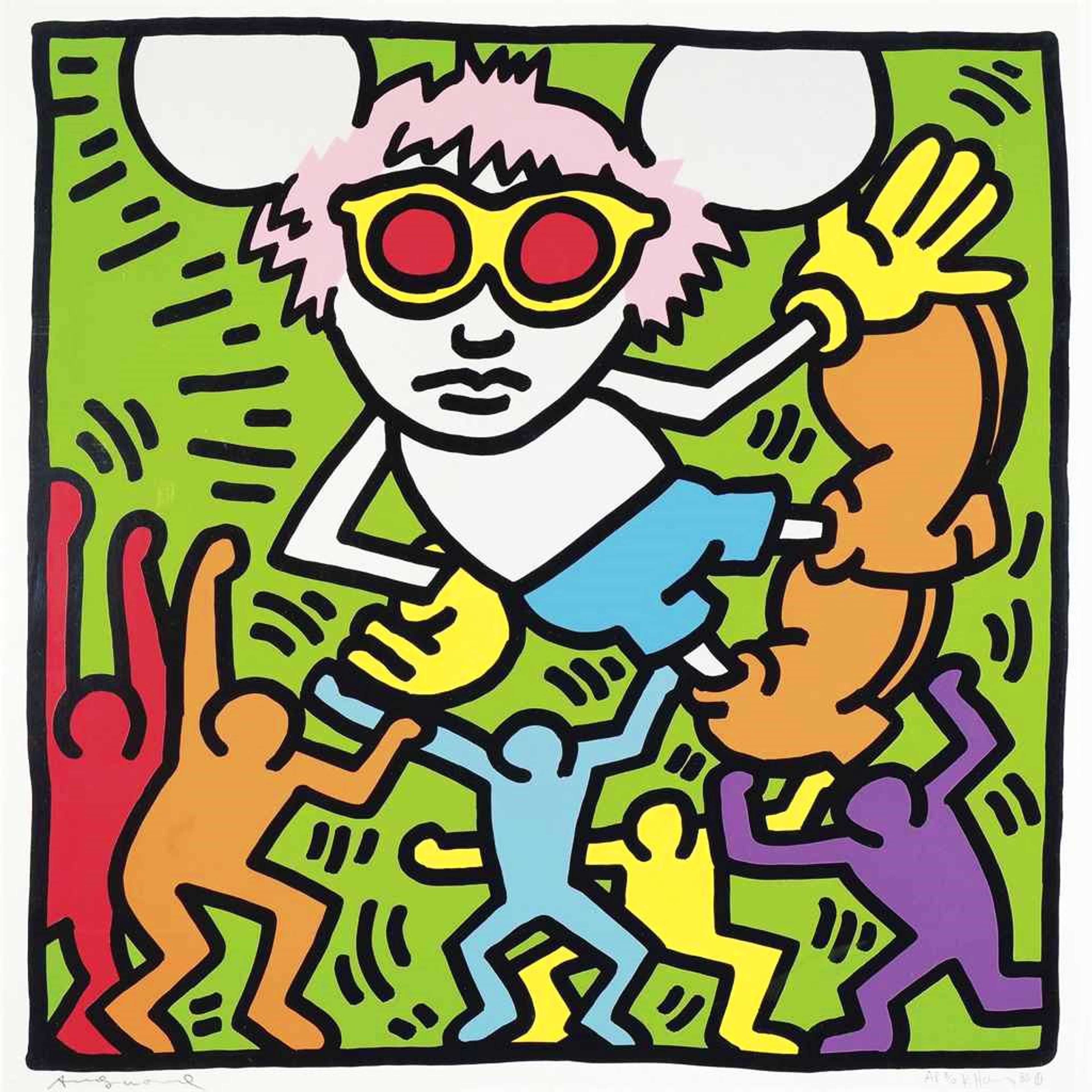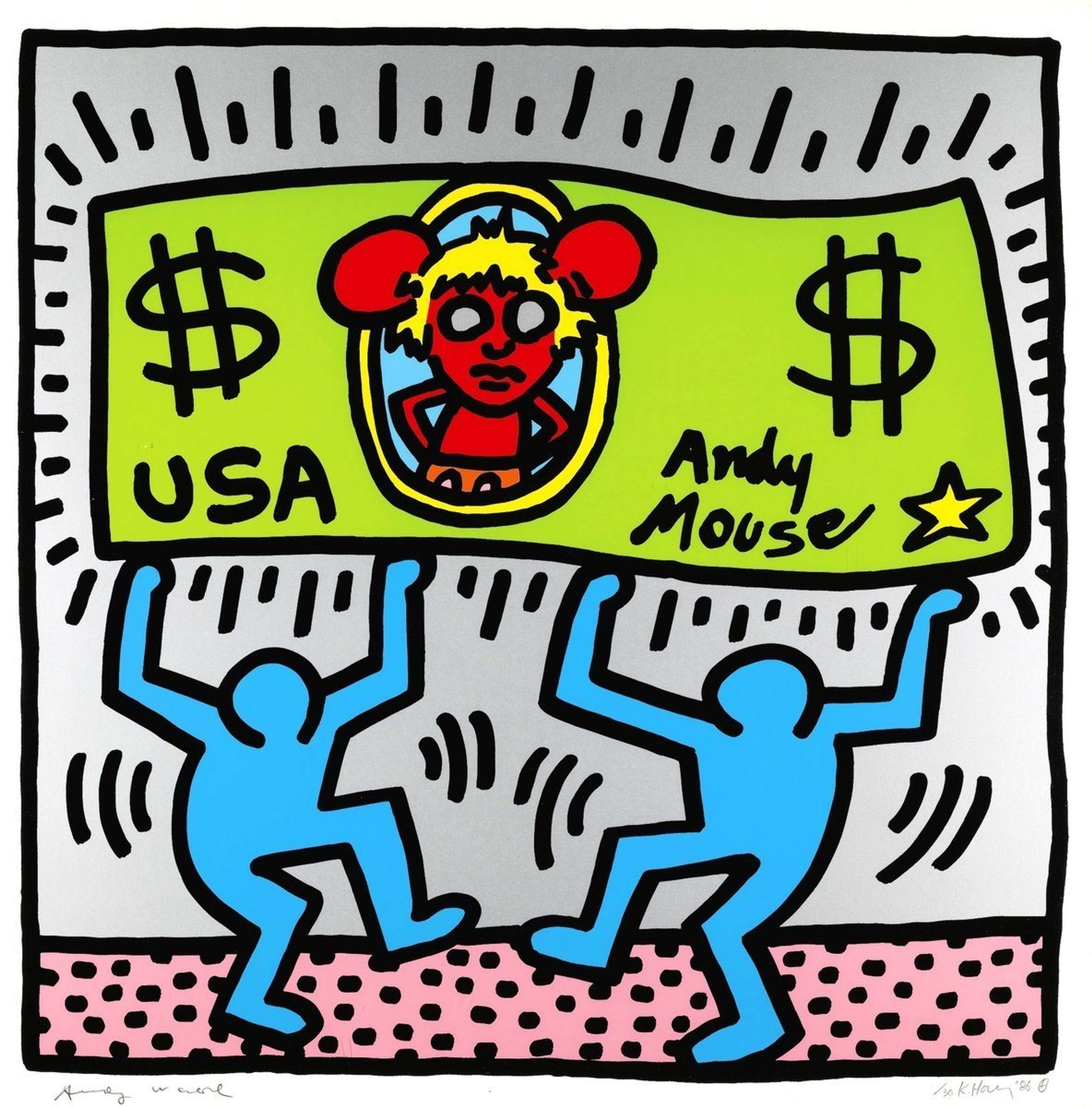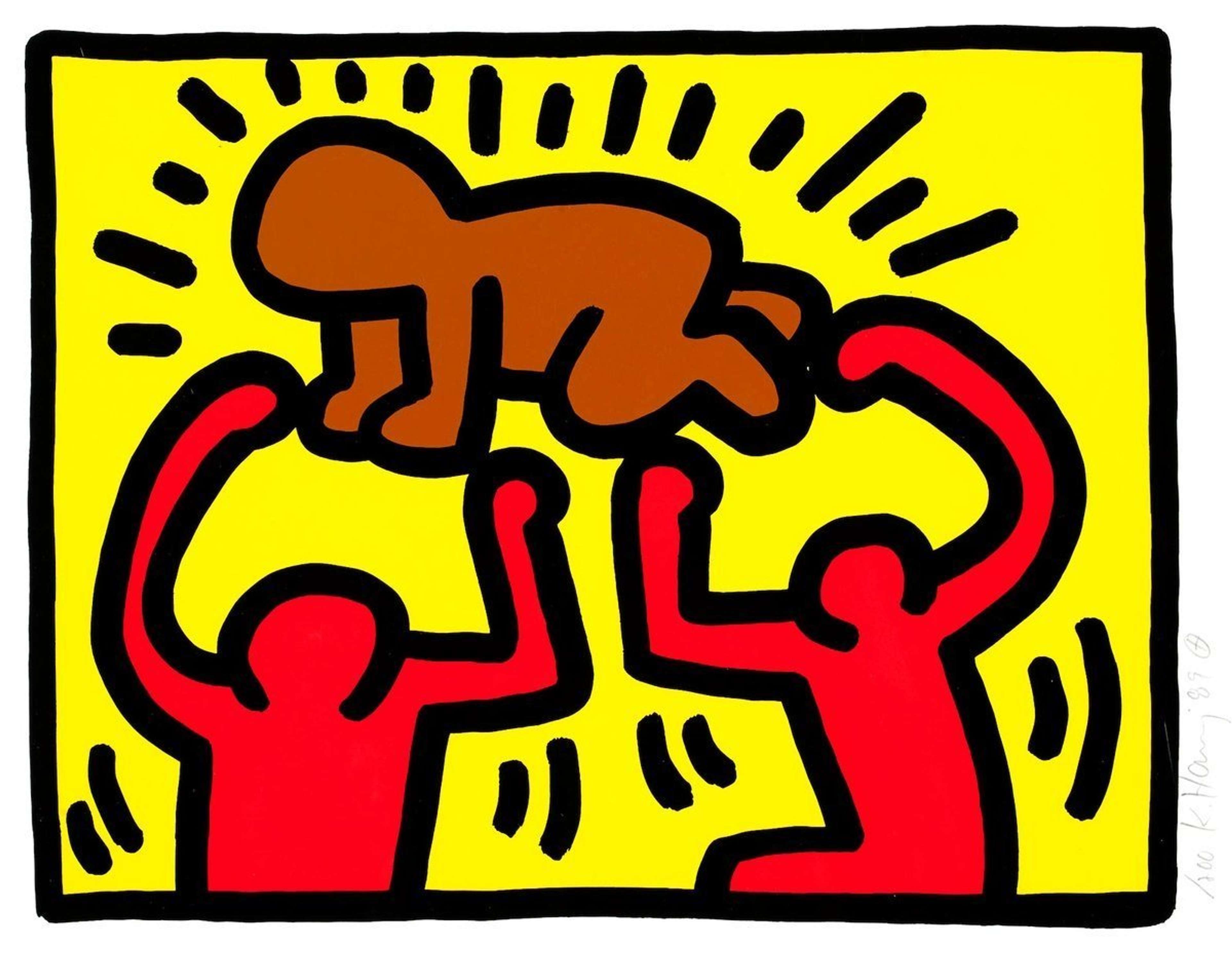 Andy Mouse 2 © Keith Haring 1986
Andy Mouse 2 © Keith Haring 1986
Interested in buying or selling
Keith Haring?

Keith Haring
249 works
Keith Haring's Andy Mouse series pays homage to his mentor and the father of Pop Art: Andy Warhol. United by their deep-set fascination with consumer culture, Haring and Warhol collaborated to produce this Disney-inspired series, with a tongue-in-cheek critique of capitalism.
Haring's friendship with Andy Warhol had a profound impact on his work.
 Andy Mouse 4 © Keith Haring 1986
Andy Mouse 4 © Keith Haring 1986After their first meeting at the Tony Shafrazi Gallery in 1984, Keith Haring introduced Andy Warhol to Manhattan’s creative scene, an environment that continued to inspire the founding father of Pop Art throughout his career.
A major influence on the younger artist’s style and subject matter, Warhol holds a prominent position within Haring’s body of work. Apart from the Andy Mouse series, Warhol appears in Haring’s drawings, many of which combine playfulness with a sense of reverence for the figurehead of Pop Art.
The series is Haring’s homage to his friend and mentor.
 Keith Haring And Juan Dubose © Andy Warhol 1983 © Sotheby's
Keith Haring And Juan Dubose © Andy Warhol 1983 © Sotheby'sBecoming part of Warhol’s creative world, Haring was able to interact with artists from beyond his own generation. Meeting performers, singers, and artists who surrounded Warhol turned out to be crucial for Haring’s realisation of such ambitious projects lying at the intersection of performance, music, dance, and visual art.
It was through his friendship with Warhol that Haring managed to collaborate with Grace Jones on his famous body painting project. Haring wrote in his diary: "Andy’s life and work made my work possible in the first place. Andy created the precedent for the possibility of my art to exist".
Andy Mouse is an example of Haring’s signature visual language.
 Andy Mouse 2 © Keith Haring 1986
Andy Mouse 2 © Keith Haring 1986Throughout his 12-year career, Keith Haring produced public murals, subway drawings, and politically engaged posters that cemented his role as a spokesperson for social equality and the importance of collective action.
Through his art and activism, Haring represented a non-conformist stance on topics ranging from racism, homophobia to nuclear annihilation. Vividly thick lines, combined with gaudy colours and cartoon-like, simplistic style of representation are all present in Andy Mouse, exemplifying the distinctive features of Haring’s visual language.
The relationship between Warhol's public image and the surrounding world of mass media inspired Haring.
 The Shadow (unique) © Andy Warhol 1981
The Shadow (unique) © Andy Warhol 1981Haring’s choice to depict Warhol against a cartoon world background critiques the phenomenon of fame. Warhol was a peculiar American icon as he was both championed by the masses and pervaded public imagination. By intermingling Walt Disney's imagery with Andy Warhol’s likeness, Haring problematizes the relationship between mass production and artistic practice.
Andy Mouse engages with the motif of money, media, and art to question what propels cultural stardom.
 Andy Mouse 3 © Keith Haring 1986
Andy Mouse 3 © Keith Haring 1986Haring’s Andy Mouse is depicted either wearing dollar signs or surrounded by them, criticising the traps of commodification, wealth, and luxury. The Andy Mouse character thus plays with the notions of 'high' and 'low' culture, and complicates the world of commodity and commercial production.
Warhol and Haring shared an admiration for Walt Disney.
 The New Spirit (Donald Duck) (F. & S. II.357) © Andy Warhol 1985
The New Spirit (Donald Duck) (F. & S. II.357) © Andy Warhol 1985Haring was introduced to Andy Warhol following his second exhibition in New York at the Tony Shafrazi Gallery in 1984. It was during this encounter that Warhol and Haring discovered their mutual fascination with an "Art for Everybody", as well as an admiration for Walt Disney. In that sense, Andy Mouse is a hybrid character mediating Haring’s appreciation for his two heroes: Warhol and Disney.
Haring’s screen printing technique in Andy Mouse erases distinctions between fine and popular art.
 Andy Mouse (complete set) © Keith Haring 1986
Andy Mouse (complete set) © Keith Haring 1986One of the newest printmaking media at the time, screen printing was used by Haring to produce Andy Mouse. Each work is part of a series of four silkscreen prints on paper, all of which are signed by both Haring and Warhol. An ideal medium for reproducing patterns and popular imagery, the technique represents Haring’s interest in the notions of 'high' and 'low' culture.
The Andy Mouse motif is characterised by a wry look at global fame and celebrity culture.
 Andy Mouse 1 © Keith Haring 1986
Andy Mouse 1 © Keith Haring 1986The Andy Mouse series celebrates Warhol’s trailblazing contributions to Pop Art while preserving a wry look at the capitalist foundations of global fame and celebrity culture. With its recurrent use of the dollar sign, the series hints at the explicitly political motifs of Haring’s works: the excess and alienation defining consumer culture.
The series captures how Haring’s art creates a world for adults and children.
 Pop Shop IV, Plate III © Keith Haring 1989
Pop Shop IV, Plate III © Keith Haring 1989Famous for his collaborative approach to art and generous support of social causes, Keith Haring created many of his artworks with children's viewership in mind. Inspired by both Andy Warhol and Walt Disney’s legacy, the series intertwines a simplistic visual language with socially engaged subject matter, exemplifying how Haring’s art creates a world for adults and children.
Mickey Mouse was frequently appropriated by Haring's contemporaries.
 Look Mickey © Roy Lichtenstein 1961
Look Mickey © Roy Lichtenstein 1961 Another artist who saw Mickey Mouse as a potent symbol of his times is Roy Lichtenstein. The artist entered the most famous phase of his career when he repainted an illustration of Mickey Mouse in Look Mickey in 1961. Both Lichtenstein and Haring’s engagement with the Disney character captures how Pop Art artists reappropriated motifs from mundane sources, such as comic books and advertisements.
